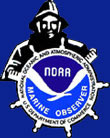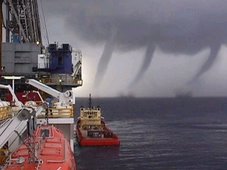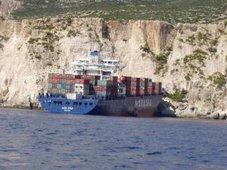
Jerry Dennis & Glenn Wolff
Even in the open ocean the immense waves of popular imagination are rarely encountered. At least three-quarters of all sea waves have a height less than 12 feet, and only very powerful storms produce mountainous seas of more than 30 feet. Nonetheless, some parts of the oceans have earned notoriety from producing larger-than- average waves, some of them very large indeed. Many of the biggest waves that reach the shores of Europe and eastern North America originate in the middle of the North Atlantic, especially in the stormy regions south of Iceland and Greenland. The long rollers that frequently strike the southwest corner of England can begin as far south as the Cape of Good Hope, South Africa -- some 6,000 miles away. In the Pacific, swells washing on the shores of California and even Alaska have been traced to the Antarctic Ocean. The winds south of Cape Horn, at the southern tip of South America, follow the "Screaming Sixties" all the way around the world without interruption by continents. This endless fetch produces long, powerful waves known as "graybeards" or "Cape Horn Rollers" by mariners who claim they have seen them measure a mile from crest to crest and reach heights of 200 feet.
Such figures were once discounted as the result of fancy and fear by oceanographers convinced that no wave could surpass 60 feet in height without collapsing. But this "60-foot rule" has been challenged recently by computer models that seem to prove that powerful storms are capable of creating waves as high as 219 feet.
The big waves of computer models, of course, are an exercise in theory divorced from practice. In nature, waves are not nearly as predictable and orderly as they are in laboratories, computers, and mathematical equations. While features such as velocity, period, and length are easy to measure in controlled circumstances, in the open ocean they can be hopelessly confused. Swells the size of small hills come at you from several directions at once, each rising and descending unpredictably, the slopes hacked by wind waves and covered with a perplexity of tiny capillary waves. One moment a breaking curler rushes down the slope of a large swell, then a trough fills with the crest of a wave coming from the side or falls away into yet a deeper trough. The random and disorderly nature of waves in the oceans almost guarantees that they will occasionally produce waves of a higher order. Such "rogue," "freak," or "episodic" waves are known as Extreme Storm Waves (or ESW) when they develop within a storm, and often rise in groups of three that have earned the quasi-mythical designation "Three Sisters Waves." Most reports of ESWs note that they look like "walls of water," that they're accompanied by steep-sided and unusually deep troughs (deep enough to occasionally swallow a ship), and that they spill forward and break simultaneously and with equal energy the entire lengths of their crests. An enormous freak wave with those characteristics struck the Queen Mary amidships south of Newfoundland while ferrying U.S. soldiers home at the end of World War II, rolling her to within a degree or two of capsizing.
Rogue waves can occur on relatively calm seas with no storms for hundreds of miles. Trains of swells traveling in the same direction but at different speeds will pass through one another; when their crests, troughs, and lengths happen to coincide they reinforce each other, combining their energies to form unusually large waves that tower mountainously for a few minutes then subside. Such giants can suddenly reach several times the height of most of the waves around them, forming mid-ocean breakers that are probably responsible for at least some mysterious disappearances of ships. When such anomalous waves occur near shore, roaring down without warning on piers and rocky ledges, they sometimes sweep people to their deaths.
When waves meet opposition in an oncoming current the wavelength is shortened and the wave is forced to become steeper and as much as two to four times higher. Examples can be seen on a relatively small scale at the mouths of rivers or estuaries, where the outflowing current creates high choppy waves that can be dangerous for small craft. When a current exceeding about four miles per hour is spread over a large area and involves massive amounts of water the danger is magnified. Regions notorious for such hazardous juxtaposition of waves and current include the Agulhas Current off the east coast of South Africa, the Kuroshio Current southeast of Japan, and the Straits of Florida and elsewhere along the Gulf Stream, where 30-foot waves blown up by nor'easters sometimes reach 40 to 60 feet in height.
Reports of rogue waves a hundred or more feet in height are no doubt often exaggerated, but careful measurements by coolheaded observers have left little doubt that waves of that size sometimes occur. One fairly reliable way sailors have measured such waves is to climb the rigging until they reach the point, while the ship is in the bottom of a trough, at which the crest of the wave lines up with the horizon. The height climbed then equals the height of the wave. This technique, or variations on it, have been used to measure some waves of terrifying dimensions.

One of the largest waves ever measured was reported by Navy Lieutenant Commander R. P. Whitemarsh in a famous paper titled "Great Sea Waves," published in the U.S. Naval Institute Proceedings in August 1934. Whitemarsh encountered a storm on February 7, 1933, while crossing the Pacific in the navy tanker the U.S.S. Ramapo. During this storm, west winds had a fetch across thousands of miles of unobstructed ocean and had already blown at gale force for days. With the wind at 60 to 66 knots (69 to 76 miles per hour) directly from the stern and the waves consistent, without cross seas, Whitemarsh and his crew were able to estimate (based on the 478-foot length of the ship) that the length of the waves was 1,000 to 1,500 feet. Using a stopwatch they timed wave periods up to 14.8 seconds. Crew members standing on the ship's bridge could measure the height of a wave by lining up its crest with the horizon and a point on the ship's mast (making the line of sight approximately horizontal) while the stern of the ship was at the bottom of a trough. By triangulating from the line of sight to the bottom of the ship's stern (or the trough of the wave) they were able to determine the height of each wave. The largest they measured was 112 feet.
Other notable waves have been measured against stationary objects, especially lighthouses. In the winter of 1861, for example, the Bishop Lighthouse in the Isles of Scilly was struck by a wave high enough to smash a fog bell hanging 100 feet above the ground (eyewitnesses insisted the crest of the wave came down on the bell), breaking a metal support bracket four inches thick and tossing the bell to the rocks below where it smashed to pieces. Waves have occasionally passed over the top of the 75-foot-high lighthouse on Minots Ledge, Massachusetts, and have flung rocks through the glass of Oregon's Tillamook Rock Lighthouse, 133 feet above the water.
Weather Story
From IAEM supported IDER Conference in London, England.
VIETNAM: Homes of hundreds of thousands of Vietnamese villagers are still under water after days of some of the worst flooding in decades, caused by the typhoon Lekima. Up to 67 people were killed and 14 were missing. The provinces Thanh Hoa and Nghe An were worst hit by floods and landslides and its two million inhabitants are affected. Maintaining sanitary conditions and the threat of water-borne diseases is becoming real. The disasters damaged over 100,000 houses, closed roads, submerged hundreds of thousands of hectares of subsidiary crops, and disrupted electricity and telecommunications system, isolating villages in several mountainous areas. Preliminary reports said nearly 58,000 houses were damaged or destroyed.
CHINA: Typhoon Krosa caused landfall in the southern China, lashing with heavy rain and high winds up to 126 km/h. It has been downgraded to tropical storm today. No casualties were reported although over 5 million people in east China's Zhejiang Province were affected. The storm prompted evacuation of more than 1.41 million people. Transportation services were paralyzed, power supplies cut off, schooling and tourist businesses suspended, and ship services halted on Saturday.
Chicago - On Sunday October 6, 2007, we broke the record of 86 set in 1947 by one degree - 88. Unfortunately we also broke the Chicago Marathon. One died and some 300 needed medical attention. The race was called half way through... However fall has arrived so we will be moving from Construction Season to Winter.... Good Morning Chicago!
Funny side story here as told to me by a port captain for a major tug and barge company here in Chicago a while back ago.
Every winter as the lakes freeze over the USCG has to remove buoys and get the ole icebreaker ready. Though one of the local maritime companies has a tug that is ice capable. Seems that the local Indians who snow mobile over the lakes between Michigan and Wisconsin will mark the trail with small trees so that they can follow the path back home. One Captain of the ice-tug seemed to love to target and "break ice" directly in between the path of the trees so that the trail ..eh...ends... abruptly.
Water Buoys to be removed in 10 days (Oct 5, 2007)
Warning buoys upstream of seven Grand River Conservation Area dams along the Grand River will be removed the week of Oct. 15 to prepare for winter.
The buoys will be put back in place in May 2008 after the spring runoff.
Boaters using the river after the buoys are removed should exercise extra caution around the dams.
Buoy removal schedule:
*Oct. 15 - Dunnville Dam;
*Oct. 16 - Caledonia Dam, Wilkes Dam (Brantford);
*Oct. 17 - Parkhill Dam (Cambridge), New Hamburg Dam, Drimmie Dam (Elora), Bissell Dam (Elora).
The schedule is subject to change depending on weather conditions.
The buoys are installed each May to warn canoeists and kayakers about the danger of approaching these dams, which are all known as "run of the river" or "low head" dams.
The water upstream of the dams can be still and placid, but the area downstream can be dangerous.
Strong currents at the base of the dam can capsize a canoe or kayak and trap the occupant underwater.
Just a note from me
Recently I wrote a OPED which appeared in the Forth Worth Star Telegram on the mis-placement of six nuclear ACM 129 Cruise Missiles. I really shy away from politics but this incident is a very grave and serious matter not just to me but many of my peers. I sincerely hope that the USAF completes its investigation and the truth comes out. I wish to thank Paul Harral, Editor of the Editorial Page of the Forth Worth Star Telegram for taking the subject matter seriously and giving me the opportunity to go to print. His editorial skills and patience with me was just outstanding.
I cannot take full credit for the entire article, many of my peers and maritime friends coached and helped with support and questions. It was a team effort and I wish to thank them as well. I also wish to thank Susan H and Larry Johnson of No Quarter for re-printing the article. Their blog is one all must keep in their bookmarks. I also wish to thank Fred Fry of Fred Fry International and my shipmate Captain John Konrad at gCaptain for re-posting the article. Both blog's are also truly amazing like the men who write them.
RS


































































































![Validate my RSS feed [Valid RSS]](valid-rss.png)